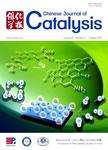Co_3O_4 supported on N,P-doped carbon as a bifunctional electrocatalyst for oxygen reduction and evolution reactions
氧还原和析氧反应的双功能电催化剂——氮磷共掺碳负载四氧化三钴(英文)作者机构:东莞理工学院广东省新型纳米材料工程技术研究中心广东东莞523808 华南理工大学化学与化工学院广东广州510640
出 版 物:《Chinese Journal of Catalysis》 (催化学报(英文))
年 卷 期:2016年第37卷第8期
页 面:1249-1256页
核心收录:
学科分类:081705[工学-工业催化] 0817[工学-化学工程与技术] 08[工学] 0703[理学-化学]
基 金:supported by the National Natural Science Foundation of China (21375016 20475022 and 21505019)~~
主 题:Cathode catalyst Oxygen reduction reaction Oxygen evolution reaction Doped carbon Cobalt
摘 要:Noble metals, such as platinum, ruthenium and iridium‐group metals, are often used as oxygen reduction or evolution reaction (ORR/OER) electrocatalysts. To reduce the cost and provide an application of bifunctional catalysis, in this work, cobalt oxide supported on nitrogen and phospho‐rus co‐doped carbon (Co3O4/NPC) was fabricated and examined as a bifunctional electrocatalyst for OER and ORR. To prepare Co3O4/NPC, NPC was pyrolyzed from melamine and phytic acid support‐ed on carbon, followed by the solvothermal synthesis of Co3O4 on NPC. Linear sweep voltammetry was used to evaluate the activity for OER and ORR. For OER, Co3O4/NPC showed an onset potential of 0.54 V (versus the saturated calomel electrode) and a current density of 21.95 mA/cm2 at 0.80 V, which was better than both Co3O4/C and NPC. The high activity of Co3O4/NPC was attributed to a synergistic effect of the N, P co‐dopants and Co3O4. For ORR, Co3O4/NPC exhibited an activity close to commercial Pt/C in terms of the diffusion limited current density (–4.49 vs–4.76 mA/cm2 at–0.80 V), and Co3O4 played the key role for the catalysis. Chronoamperometry (current versus time) was used to evaluate the stability, which showed that Co3O4/NPC maintained 46%current after the chronoamperometry test for OER and 95% current for ORR. Overall, Co3O4/NPC exhibited high activity and improved stability for both OER and ORR.



